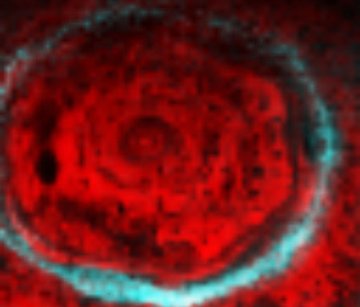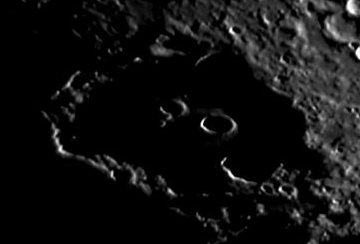 Did you miss last night's auroras? Next time get a wake-up call from Spaceweather PHONE.
Did you miss last night's auroras? Next time get a wake-up call from Spaceweather PHONE.
ASTEROID FLYBY: Asteroid 2006 VV2 is about to fly past Earth. On March 30th around 11 pm PDT the 2 km-wide space rock will streak through the constellation Leo only 2 million miles away glowing like a 9th-to-10th magnitude star. This makes it an easy target for backyard telescopes with CCD cameras. Observers in the Americas are favored. [ephemeris] [3D orbit]
BIZARRE HEXAGON: "We've never seen anything like it on any other planet," says atmospheric scientist Kevin Baines of the Jet Propulsion Laboratory. It is a hexagon twice as wide as Earth encircling Saturn's north pole. First observed by the Voyager spacecraft in the 1980s, the hexagon has been sighted anew by the Cassini probe:

In this infrared photo taken by Cassini's VIMS camera, the blue color traces auroras at high altitudes in Saturn's atmosphere. Red indicates the amount heat filtering up through clouds below. Researchers believe the auroras and the hexagon are unrelated.
The hexagon could be a distant cousin of Earth's polar vortex, but while Earth's vortex is a circle, Saturn's may be molded into a hexagon by some strange pattern of atmospheric waves. "Saturn's thick atmosphere where circularly-shaped waves and convective cells dominate is perhaps the last place you'd expect to see such a six-sided geometric figure," says Baines. In short, it's a mystery.
It's a mystery you can ponder tonight while looking at Saturn with your own two eyes. The ringed planet rises in the east at sunset right beside the Moon. You can't miss it: sky map. If you have a telescope, point it at Saturn. You won't be able to see the hexagon because Saturn's north pole is tilted away from Earth, but you will see Saturn's breathtaking rings and largest moons. Very nice!
Hexagon links: press release, movie, Cassini home page
THE EYES OF CLAVIUS: When you're done looking at Saturn, swing your telescope a little to the left and target the Moon. Last night in the Netherlands, "I looked through the eyepiece of my 10-inch LX200 and noticed Clavius staring back at me," says Jan Timmermans who took this picture:

Clavius is the third largest lunar crater visible from Earth. It's so big it has craters of its own. Light and shadow playing across two of them temporarily created these "eyes of Clavius."
Advice: If you do look at the Moon tonight, scan your telescope along the terminator--the day-night divide where shadow and light transform the lunar landscape into unfamiliar and fantastic scenes. You never know what you might find staring back at you.

